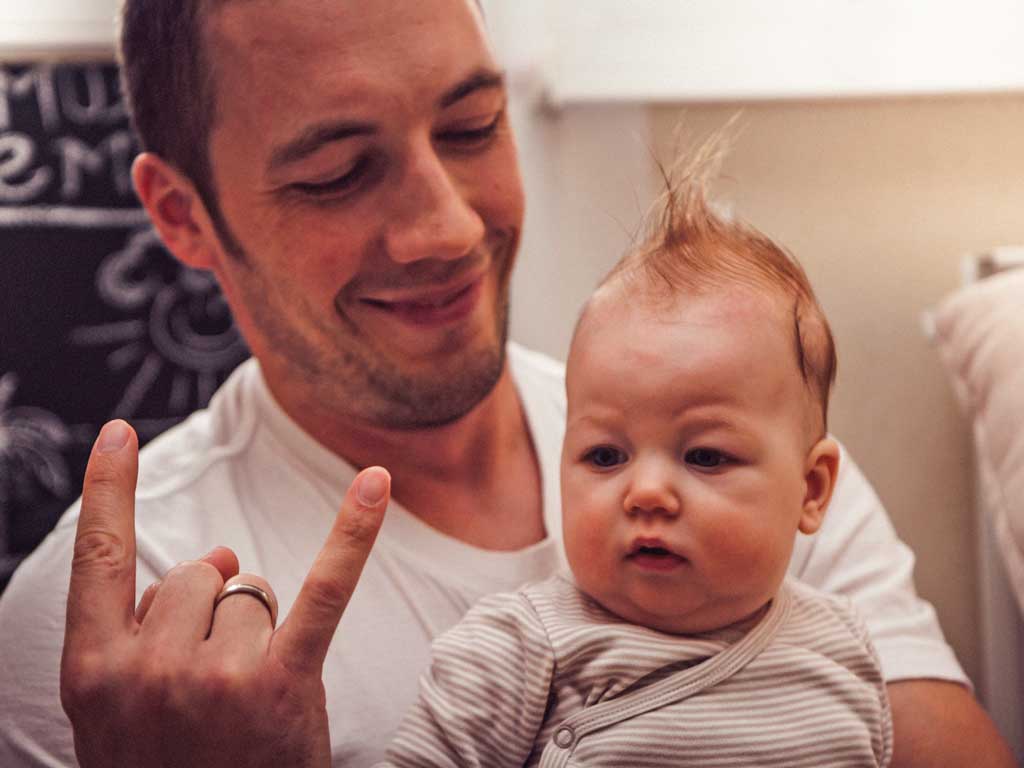by Sara Tiller
Learning sign language is more popular today than ever before. Both hearing and deaf families now teach their children to sign. Baby sign language, once unknown outside of the deaf community, is now used at home and in preschools. And companies that make baby sign language toys are expanding quickly.
At the university level, sign language enrollment has also surged. It’s now the third most common second language learned. Enrollments in sign language courses are growing faster than those in any other foreign language.

Baby Sign Language
Baby sign language is the most well-known type of sign language in America. Most of the signs used come from American Sign Language, or ASL. But babies usually don’t learn enough to be considered truly bilingual.
Most parents start teaching their kids sign language when their children are between six months and a year old. And kids can start signing back at as young as one year old.
Most parents say that cutting down on frustration is the biggest benefit. Basic signs like milk, food, or play can help kids communicate their wants. Because kids learn to talk much later, the frustration of not being understood contributes to lots of tantrums.
Being able to sign these desires helps to reduce tantrums and stress for both parents and kids.
But learning sign language has other benefits, too.
- Kids who learn to sign usually have better fine motor skills than kids who don’t
- Kids have a wider vocabulary and better spelling abilities
- Signing usually corresponds to a better ability to read body language
Parents sometimes avoid teaching their kids baby sign language because of misunderstandings. We’ve rounded up some of the most common myths about sign language, and what educators have to say about them.
The Myth: Kids won’t talk, or will talk late, if they learn sign language.
The Reality: Sign language actually has the opposite effect. Most kids who learn sign language will develop verbal skills slightly earlier than their non-signing peers. It’s also common for them to have a bigger vocabulary and better spelling skills.
The Myth: Sign language is only used by Deaf and Hard of Hearing individuals.
The Reality: Sign language is actually used by a number of groups. Kids who have delayed verbal development often use sign language to communicate. And increasingly, kids with developmental delays, Down’s Syndrome, and Autism are learning sign language to communicate as well.
The Myth: Sign language stops being useful once kids can talk.
The Reality: Educators are learning that sign language is useful in the classroom through elementary and high school. Some schools now teach all students basic signs to help teachers with classroom management. Using signs allows teachers to see and respond to student requests for bathroom breaks, water or snacks, and other needs without interrupting their lesson.
How Do You Teach Sign Language?
Start signing to your baby when he or she is around six months old. Pick just a few signs to start with, and make sure they’re ones your baby will use regularly. Mom, dad, and milk are good words to start with.
When you begin teaching your baby to sign, remember these three principles:
- Play
- Repeat
- Reward
Don’t expect your child to start signing immediately. Children often don’t have the motor skills needed to sign until they’re nearly a year old. Even then, their signs might not be perfect.
As your child grows, encourage her interest in sign language by teaching her new signs related to her interests. A child who loves animals might enjoy learning the signs for cat, dog, or mouse. And a kid who’s interested in trucks might enjoy the signs for car or dump truck.
Many parents and caregivers have experienced the frustration of teaching their child to sign, only to realize that nobody else understand what she’s signing.
Consider using flash cards or signing posters to keep your child’s caregivers on the same page. Babysitters and family members can refer to it to figure out what your child is saying. You can print out a free chart of commonly used signs from babysignlanguage.com/chart.

Beyond Baby Sign Language
If you want to learn more than just a few signs, considering reaching out to the Deaf community on the islands. American Sign Language, where most baby signs come from, is a beautiful language that most baby signers see just the tip of.
Sarah Comerford, a sign language interpreter in Honolulu, encourages families to go beyond baby sign language. “People should give their kids access to the whole range of Deaf culture – these are a beautiful people and this is a beautiful language,” she says.
Kids who continue with sign language see the benefits of true bilingualism, too. Being fluent in sign language has functional, cognitive, and behavioral benefits. Bilingual kids tend to perform better on math and logic tests, and have an easier time with abstract concepts. They’re also able to move between cultures, which is increasingly important in our world.
Being fluent in sign language can also help down the road. Bilingual adults tend to have more job opportunities. They also earn an average of $7,000 more than their peers.
Finding Sign Language Resources
Hawaii has an active Deaf culture. Honolulu, in particular, has a number of opportunities for families to get involved with the Deaf culture. Sarah Comerford helped us put together this list of some of Honolulu’s best resources for learning ASL.
The Deaf Center at Kapiolani Community College offers programs for deaf and hard of hearing children, their families, and teachers. If your child is deaf or hard of hearing, the Center is a great place to find support, resources, and education. They also offer sign language classes, training for sign language interpreters, and community events.
Deaf News Hawaii: This group provides both a newsletter and a Facebook group. They coordinate a range of meetups and social events throughout the islands. They also provide information about festivals, events, and volunteer opportunities.
The Hawaii School for the Deaf and Blind: The school offers a wide range of afterschool programs, including family education about sign language and deaf culture. They also have a number of volunteer opportunities for people who know sign language, regardless of whether they’re deaf or hard of hearing. The school coordinates Project Read Aloud, which encourages families to read to their children in ASL.
10 Essential Signs
- MORE
- DONE
- EAT
- MILK
- HELP
- WATER
- PLAY
- CHANGE
- MOM
- DAD





